Soft Computing Approach to Design a Triple-Band Slotted Microstrip Patch Antenna
Abstract
1. Introduction
2. Theory of Support Vector Regression
3. Design of Triple-Band Antenna
4. Simulation and Implementation
5. Antenna Design via HFSS Optimization Tool
6. Conclusions
Author Contributions
Funding
Institutional Review Board Statement
Informed Consent Statement
Data Availability Statement
Conflicts of Interest
References
- Zadeh, L.A. Soft computing and fuzzy logic. IEEE Softw. 1994, 11, 48–56. [Google Scholar] [CrossRef]
- Zadeh, L.A. Fuzzy logic = computing with words. IEEE Trans. Fuzzy Syst. 1996, 4, 103–111. [Google Scholar] [CrossRef]
- Goldberg, D.E. Genetic Algorithms in Search, Optimization and Machine Learning Reading; Addison-Wesley: Boston, MA, USA, 1989. [Google Scholar]
- Haupt, R.L. An introduction to genetic algorithms for electromagnetics. IEEE Antennas Propag. Mag. 1995, 37, 7–15. [Google Scholar] [CrossRef]
- Weile, D.S.; Michielssen, E. Genetic algorithm optimization applied to electromagnetics: A review. IEEE Trans. Antennas Propag. 1997, 45, 343–353. [Google Scholar] [CrossRef]
- Johnson, J.M.; Rahmat-Samii, V. Genetic algorithms in engineering electromagnetics. IEEE Antennas Propag. Mag. 1997, 39, 7–21. [Google Scholar] [CrossRef]
- Haupt, R.L.; Werner, D.H. Genetic Algorithm in Electromagnetics; Wiley-Interscience: Hoboken, NJ, USA, 2007. [Google Scholar]
- Haupt, R.L. Thinned arrays using genetic algorithms. IEEE Trans. Antennas Propag. 1994, 42, 993–999. [Google Scholar] [CrossRef]
- Kennedy, J.; Eberhart, R. Particle swarm optimization. In Proceedings of the ICNN’95—International Conference on Neural Networks, Perth, WA, Australia, 27 November–1 December 1995. [Google Scholar] [CrossRef]
- Robinson, J.; Rahmat-Samii, Y. Particle swarm optimization in electromagnetics. IEEE Trans. Antennas Propag. 2004, 52, 397–407. [Google Scholar] [CrossRef]
- Boeringer, D.W.; Werner, D.H. Particle swarm optimization versus genetic algorithms for phased array synthesis. IEEE Trans. Antennas Propag. 2004, 52, 771–779. [Google Scholar] [CrossRef]
- Taguchi, G.; Chowdury, S.; Wu, Y. Taguchi’s Quality Engineering Handbook; Wiley-Interscience: Hoboken, NJ, USA, 2005. [Google Scholar]
- Boyd, S.; Vandenberghe, L. Convex Optimization; Cambridge University Press: Cambridge, UK, 2004; Available online: https://web.stanford.edu/~boyd/cvxbook/bv_cvxbook.pdf (accessed on 8 October 2022).
- Tsai, J.-T.; Liu, T.-K.; Chou, J.-H. Hybrid Taguchi-genetic algorithm for global numerical optimization. IEEE Trans. Evol. Comput. 2004, 8, 365–377. [Google Scholar] [CrossRef]
- Afsari, A.; Abbosh, A.; Rahmat-Samii, Y. Adaptive beamforming by compact arrays using evolutionary optimization of Schelkunoff polynomials. IEEE Trans. Antennas Propag. 2022, 70, 4485–4497. [Google Scholar] [CrossRef]
- Weng, W.; Yang, F.; Elsherbeni, A.Z. Linear antenna array synthesis using Taguchi’s method: A novel optimization technique in electromagnetics. IEEE Trans. Antennas Propag. 2007, 55, 723–730. [Google Scholar] [CrossRef]
- Günel, T.; Aydemir, E. Application of continuous parameter genetic algorithm to the problem of synthesizing bandpass distributed amplifiers. AEU-Int. J. Electron. Commun. 2002, 56, 351–354. [Google Scholar] [CrossRef]
- Günel, T.; Yiğit, M.E.; Günel, G.Ö. Genetic-based approach to the synthesis of rectangular microstrip antenna elements with reduced mutual coupling. In Proceedings of the 2018 International Symposium on Advanced Electrical and Communication Technologies (ISAECT), Rabat, Morocco, 21–23 November 2018. [Google Scholar] [CrossRef]
- Vapnik, V.N. An overview of statistical learning theory. IEEE Trans. Neural Netw. 1999, 10, 988–999. [Google Scholar] [CrossRef] [PubMed]
- Haykin, S. Neural Networks and Learning Machines, 3rd ed.; Pearson Prentice Hall: Hoboken, NJ, USA, 2009. [Google Scholar]
- Khan, T.; De, A. Modeling of microstrip antennas using neural networks techniques: A review. Int. J. RF Microw. Comp. Aid. Eng. 2015, 25, 747–757. [Google Scholar] [CrossRef]
- Khan, T.; De, A. Prediction of slot-shape, slot-size and inserted air-gap of a microstrip antenna using knowledge-based neural network. Prog. Electromagn. Res. C 2016, 65, 23–32. [Google Scholar] [CrossRef][Green Version]
- Jain, S.K. Bandwidth enhancement of patch antennas using neural network dependent modified optimizer. Int. J. Microw. Wirel. Technol. 2016, 8, 1111–1119. [Google Scholar] [CrossRef]
- Aneesh, M.; Singh, A.; Ansari, J.A.; Kamakshi; Sayeed, S.S. Investigations for performance improvement of X-shaped RMSA using artificial neural network by predicting slot size. Prog. Electromagn. Res. C 2014, 47, 55–63. [Google Scholar] [CrossRef][Green Version]
- Günel, T. Combination of artificial neural network model with genetic algorithm for the synthesis of microstrip radial stub. AEU-Int. J. Electron. Commun. 2000, 54, 241–243. [Google Scholar]
- Aşık, U.; Günel, T.; Erer, I. A wavelet-based radial basis function neural network approach to the inverse scattering of conducting cylinders. Microw. Opt. Technol. Lett. 2004, 41, 506–510. [Google Scholar] [CrossRef]
- Guney, K.; Sarikaya, N. A hybrid method based on combining artificial neural network and fuzzy inference system for simultaneous computation of resonant frequencies of rectangular, circular, and triangular microstrip antennas. IEEE Trans. Antennas Propag. 2007, 55, 659–668. [Google Scholar] [CrossRef]
- Cortes, C.; Vapnik, V. Support vector network. Mach. Learn. 1995, 20, 273–297. [Google Scholar] [CrossRef]
- Cai, J.; King, J.; Yu, C.; Liu, J.; Sun, L. Support vector regression-based behavioral modeling technique for RF power transistors. IEEE Microw. Wirel. Compon. Lett. 2018, 28, 428–430. [Google Scholar] [CrossRef]
- Xu, J.; Jiang, W.; Ma, L.; Li, M.; Yu, Z.; Geng, Z. Augmented time-delay twin support vector regression-based behavioral modeling for digital predistortion of RF power amplifier. IEEE Access 2019, 7, 59832–59843. [Google Scholar] [CrossRef]
- Wu, Y.; Tang, Z.; Xu, Y.; Guo, Y.; Zhang, B. Support vector regression for measuring electromagnetic parameters of magnetic thin-film materials. IEEE Trans. Magn. 2007, 43, 4071–4075. [Google Scholar] [CrossRef]
- Angiulli, G.; Cacciola, M.; Versaci, M. Microwave devices and antennas modelling by support vector regression machines. In Proceedings of the 2006 12th Biennial IEEE Conference on Electromagnetic Field Computation, Miami, FL, USA, 30 April–3 May 2006. [Google Scholar] [CrossRef]
- Tokan, N.T.; Gunes, F. Support vector design of the microstrip antenna. In Proceedings of the 2008 IEEE 16th Signal Processing, Communication and Applications Conference, Aydin, Turkey, 20–22 April 2008. [Google Scholar] [CrossRef]
- Roy, C.; Khan, T.; Kanaujia, B. Performance parameters prediction of slotted microstrip antennas with modified ground plane using support vector machine. Int. J. Microw. Wirel. Technol. 2016, 9, 1169–1177. [Google Scholar] [CrossRef]
- Yiğit, M.E.; Günel, T.; Günel, G.Ö. PSO based approach to the synthesis of a cylindrical-rectangular ring microstrip conformal antenna using SVR models with RBF and wavelet kernels. In Proceedings of the 2018 18th Mediterranean Microwave Symposium (MMS), Istanbul, Turkey, 31 October–2 November 2018. [Google Scholar] [CrossRef]
- Dai, X.W.; Mi, D.L.; Wu, H.T.; Zhang, Y.H. Design of Compact Patch Antenna Based on Support Vector Regression. Radioengineering 2022, 31, 339–345. [Google Scholar] [CrossRef]
- Ansys, HFSS 3D High Frequency Simulation Software. Available online: https://www.ansys.com/products/electronics/ansys-hfss (accessed on 8 October 2022).
- Dassault Systems, CST Studio Suite Electromagnetic Field Simulation Software. Available online: https://www.3ds.com/products-services/simulia/products/cst-studio-suite (accessed on 8 October 2022).
- Cadence, AWR Software Microwave Office. Available online: https://www.awr.com/awr-software/products/microwave-office (accessed on 8 October 2022).
- Verma, S.; Ansari, J.A.; Singh, A. Truncated equilateral triangular microstrip antenna with and without superstrate. Wirel. Pers. Commun. 2017, 95, 873–889. [Google Scholar] [CrossRef]
- Nirate, S.; Vani, R.M.; Hunagund, P.V.; Mallikarjun, S.L. Arc truncated suspended rectangular microstrip antenna. Int. J. Adv. Res. Electr. Electron. Instrum. Eng. 2016, 5, 1771–1775. [Google Scholar]
- Kumar, S.; Dixit, A.S.; Malekar, R.R.; Raut, H.D.; Shevada, L.K. Fifth generation antennas: A comprehensive review of design and performance enhancement techniques. IEEE Access 2020, 8, 163568–163593. [Google Scholar] [CrossRef]
- Iplikci, S. Online trained support vector machines-based generalized predictive control of non-linear systems. Int. J. Adapt. Control. Signal Processing 2006, 20, 599–621. [Google Scholar] [CrossRef]
- Smola, A.J.; Schölkopf, B. A tutorial on support vector regression. Stat. Comput. 2004, 14, 199–222. [Google Scholar] [CrossRef]
- Cristianini, N.; Shawe-Taylor, J. An Introduction to Support Vector Machines and Other Kernel-Based Learning Methods; Cambridge University Press: Cambridge, UK, 2000. [Google Scholar]
- Iplikci, S. A comparative study on a novel model-based PID tuning and control mechanism for nonlinear systems. Int. J. Robust Nonlinear Control 2009, 20, 1483–1501. [Google Scholar] [CrossRef]
- Hou, S.; Zhou, Y.; Liu, H.; Zhu, N. Wavelet support vector machine algorithm in power analysis attacks. Radioengineering 2017, 26, 890–902. [Google Scholar] [CrossRef]
- Zhang, L.; Zhou, W.; Jiao, L. Wavelet support vector machine. IEEE Trans. Syst. Man Cybern. Part B Cybern. 2004, 34, 34–39. [Google Scholar] [CrossRef]
- Parikh, U.B.; Das, B.; Maheshwari, R.P. Combined wavelet-SVM technique for fault zone detection in a series compensated transmission line. IEEE Trans. Power Deliv. 2008, 23, 1789–1794. [Google Scholar] [CrossRef]
- Du, P.; Tan, K.; Xing, X. Wavelet SVM in reproducing kernel Hilbert space for hyperspectral remote sensing image classification. Opt. Commun. 2010, 283, 4978–4984. [Google Scholar] [CrossRef]
- Balanis, C.A. Antenna Theory Analysis and Design, 3rd ed.; John Wiley & Sons, Inc.: Hoboken, NJ, USA, 2005. [Google Scholar]
- Haneishi, M.; Yoshida, S. A design method of circularly polarized rectangular microstrip antenna by one-point feed. Electron. Comm. Jpn. Part I 1981, 64, 46–54. [Google Scholar] [CrossRef]
- Mathew, S.; Anitha, R.; Deepak, U.; Aanandan, C.K.; Mohanan, P.; Vasudevan, K. A Compact tri-band dual-polarized corner-truncated sectoral patch antenna. IEEE Trans. Antennas Propag. 2015, 63, 5842–5845. [Google Scholar] [CrossRef]
- Mathworks, MATLAB. Available online: https://www.mathworks.com/products/matlab.html (accessed on 9 September 2022).
- Parveen, T.; Khan, Q.U.; Fazal, D.; Ali, U.; Akhtar, N. Design and analysis of triple band circular patch antenna. AEU-Int. J. Electron. Commun. 2019, 112, 152960. [Google Scholar] [CrossRef]
- Li, Y.; Yu, W. A miniaturized triple band monopole antenna for WLAN and WIMAX applications. Int. J. Antennas Propag. 2015, 2015, 146780. [Google Scholar] [CrossRef]
- Li, L.; Zhang, X.; Yin, X.; Zhou, L. A compact triple-band printed monopole antenna for WLAN/WiMAX applications. IEEE Antennas Wirel. Propag. Lett. 2016, 15, 1853–1855. [Google Scholar] [CrossRef]
- Zheng, Y.; Wang, P.; Hua, M.; Gao, P. Compact triple-band monopole antenna for WLAN/WiMAX applications. IEICE Electron. Express 2013, 10, 20130638. [Google Scholar] [CrossRef][Green Version]
- Paul, P.M.; Kandasamy, K.K.; Sharawi, M.S. A tri-band slot antenna loaded with split ring resonators. Microw. Opt. Technol. Lett. 2017, 59, 2638–2643. [Google Scholar] [CrossRef]
- Sarkar, D.; Saurav, K.; Srivastava, K.V. Multi-band microstrip-fed slot antenna loaded with a split-ring resonator (SRR). Electron. Lett. 2014, 50, 1498–1500. [Google Scholar] [CrossRef]
- Li, H.; Du, J.; Yang, X.-X. Compact triple-band wearable circular patch antenna for WLAN/WiMAX applications. In Proceedings of the 2021 International Symposium on Antennas and Propagation (ISAP), Taipei, Taiwan, 19–22 October 2021. [Google Scholar] [CrossRef]
- Maity, B.; Nayak, S.K. Design of compact microstrip-fed triple-band slot antenna with defected ground structure for wireless communications. J. Electromagn. Waves Appl. 2022, 36, 1702–1716. [Google Scholar] [CrossRef]
- Hooke, R.; Jeeves, T.A. Direct search solution of numerical and statistical problems. J. ACM 1961, 8, 212–229. [Google Scholar] [CrossRef]
- Torczon, V. On the Convergence of pattern search algorithms. SIAM J. Optim. 1997, 7, 1–25. [Google Scholar] [CrossRef]
- Gardeux, V.; Omran, M.G.H.; Chelouah, R.; Siarry, P.; Glover, F. Adaptive pattern search for large-scale optimization. Appl. Intell. 2017, 45, 319–330. [Google Scholar] [CrossRef]
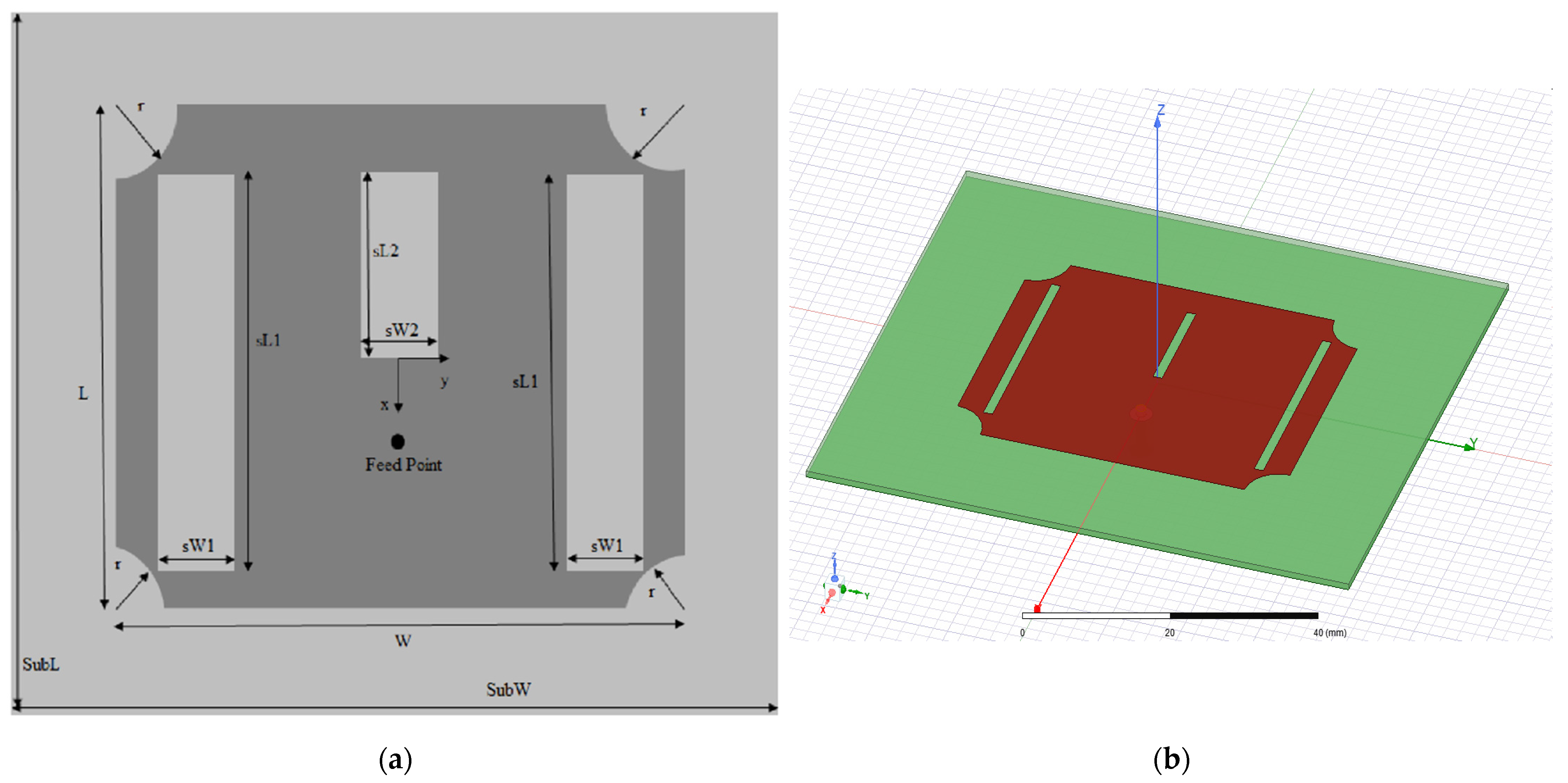
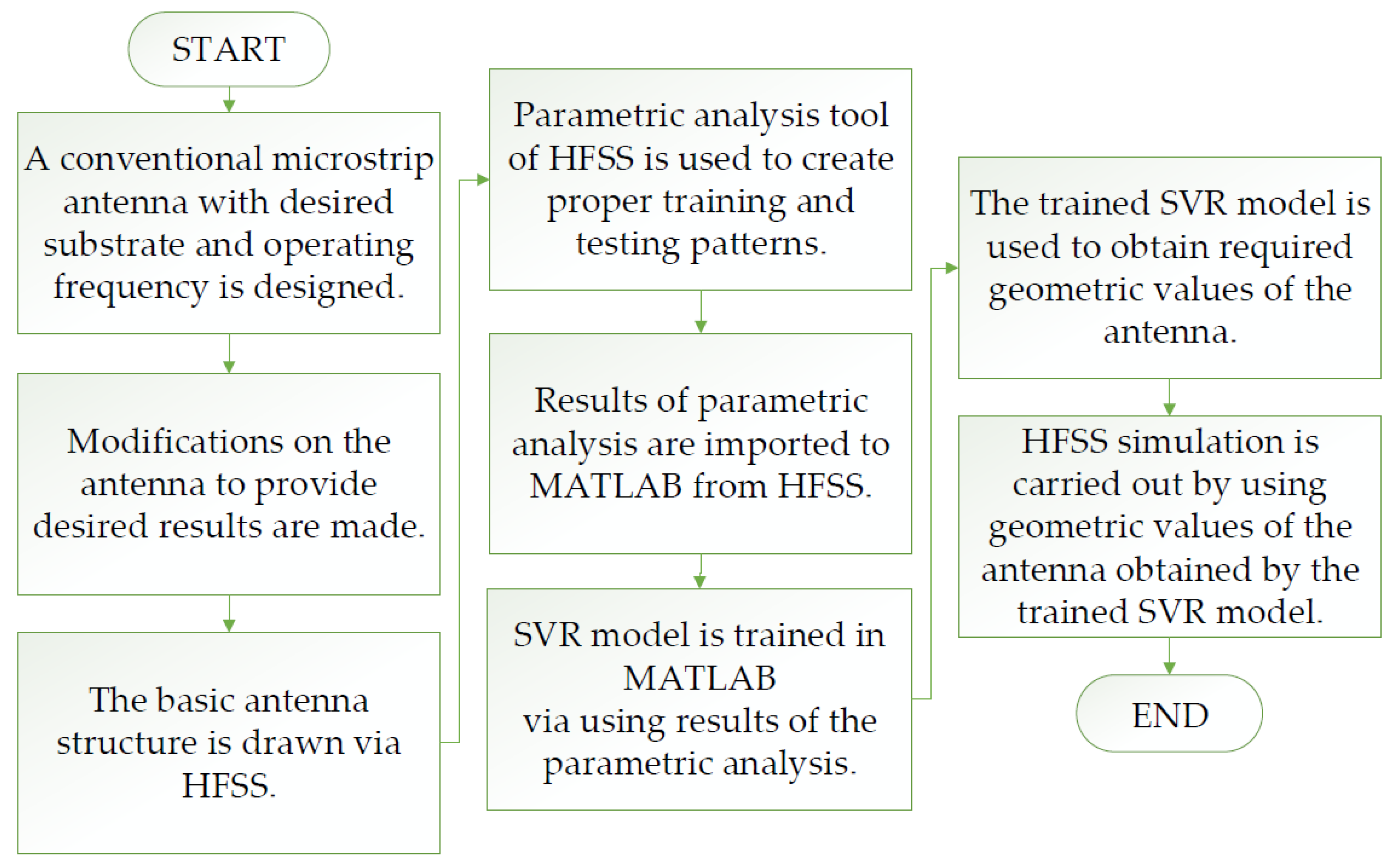
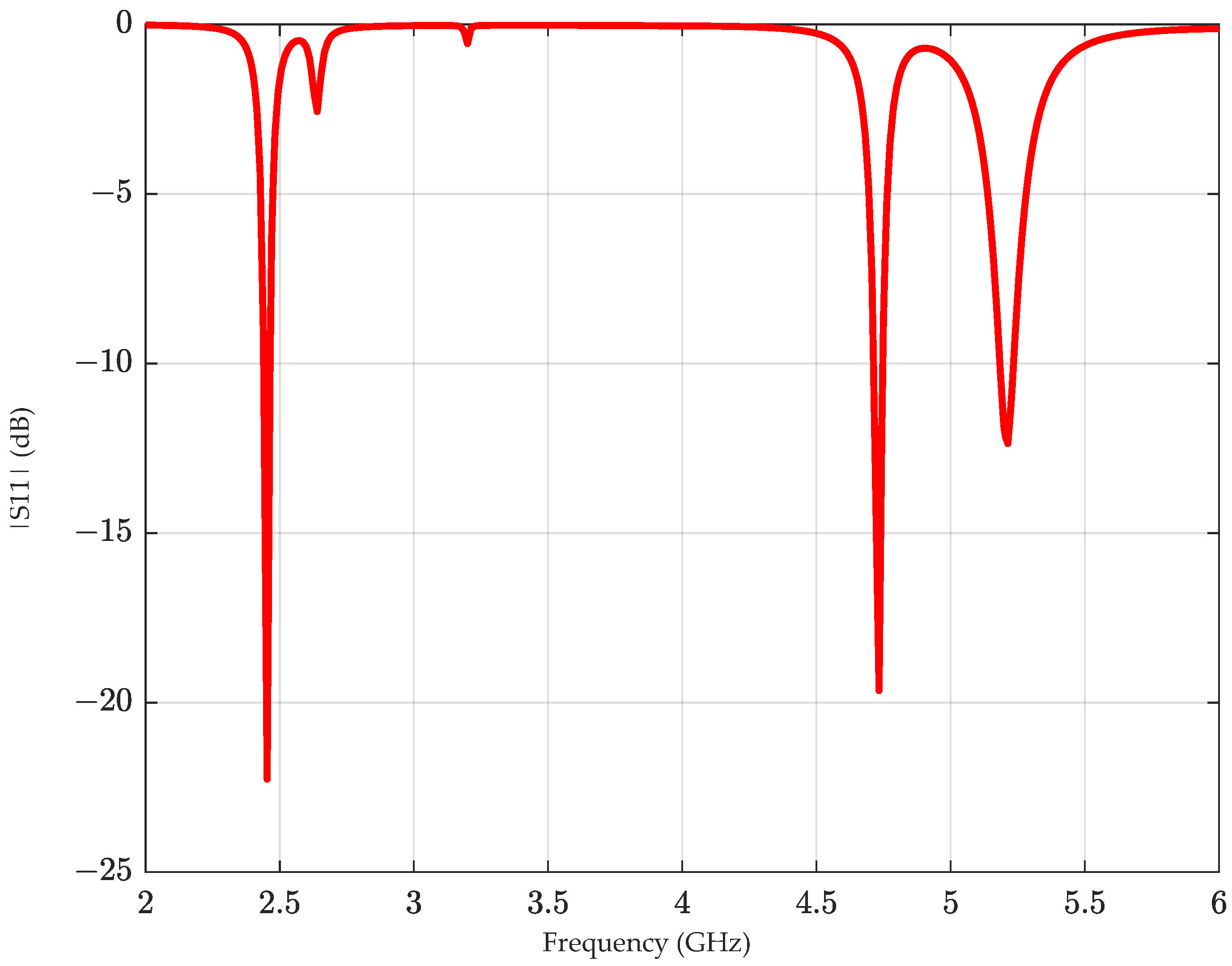

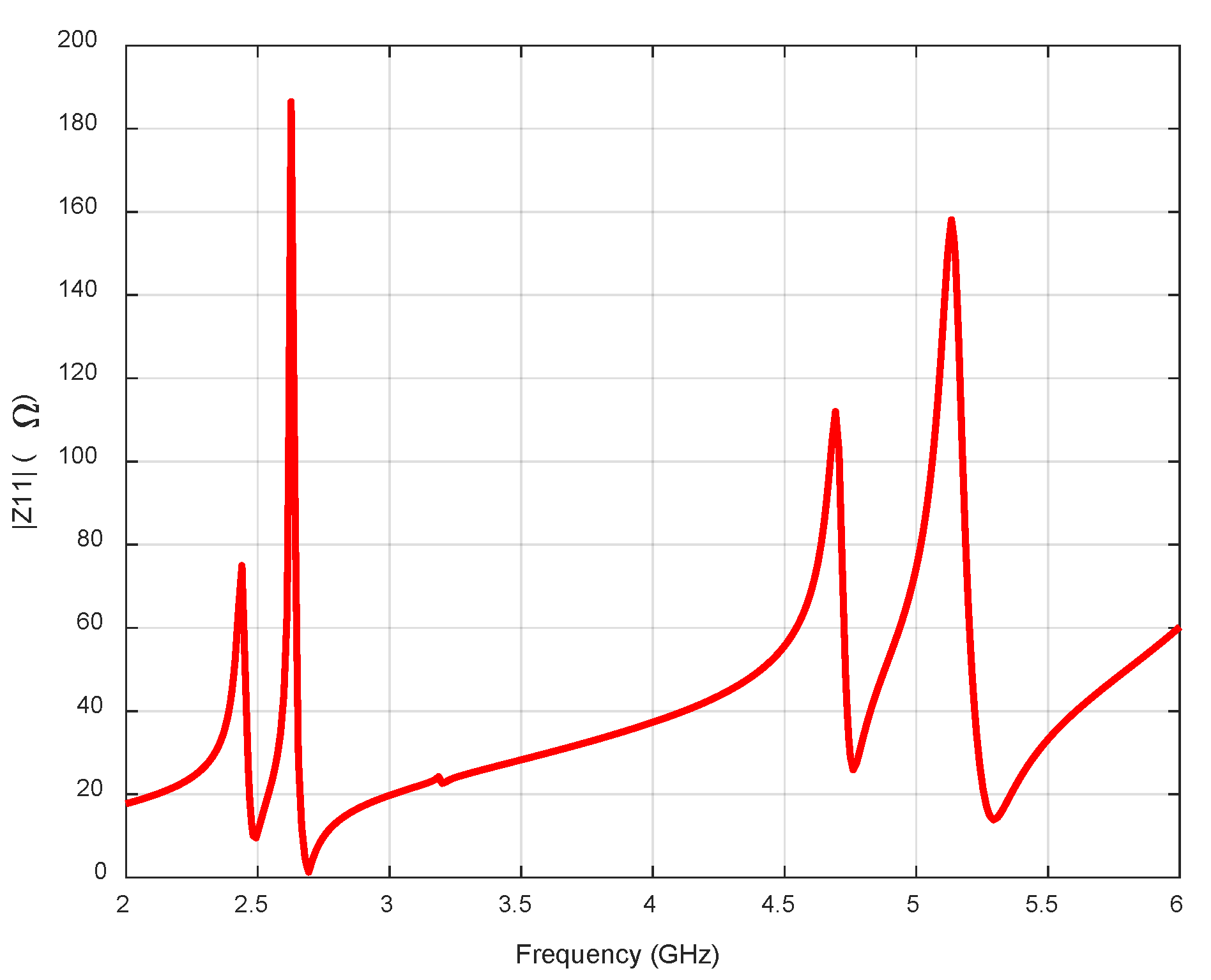
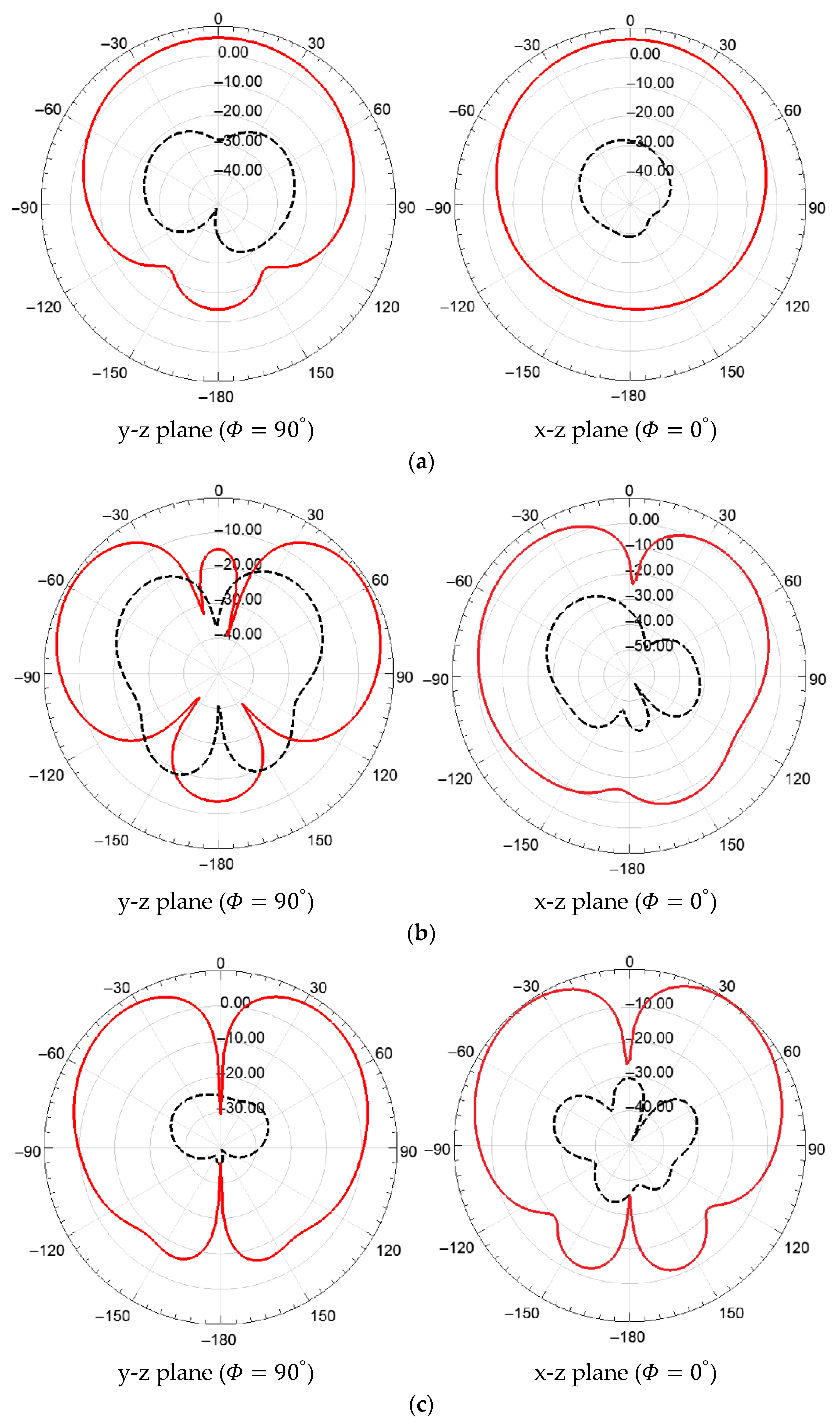

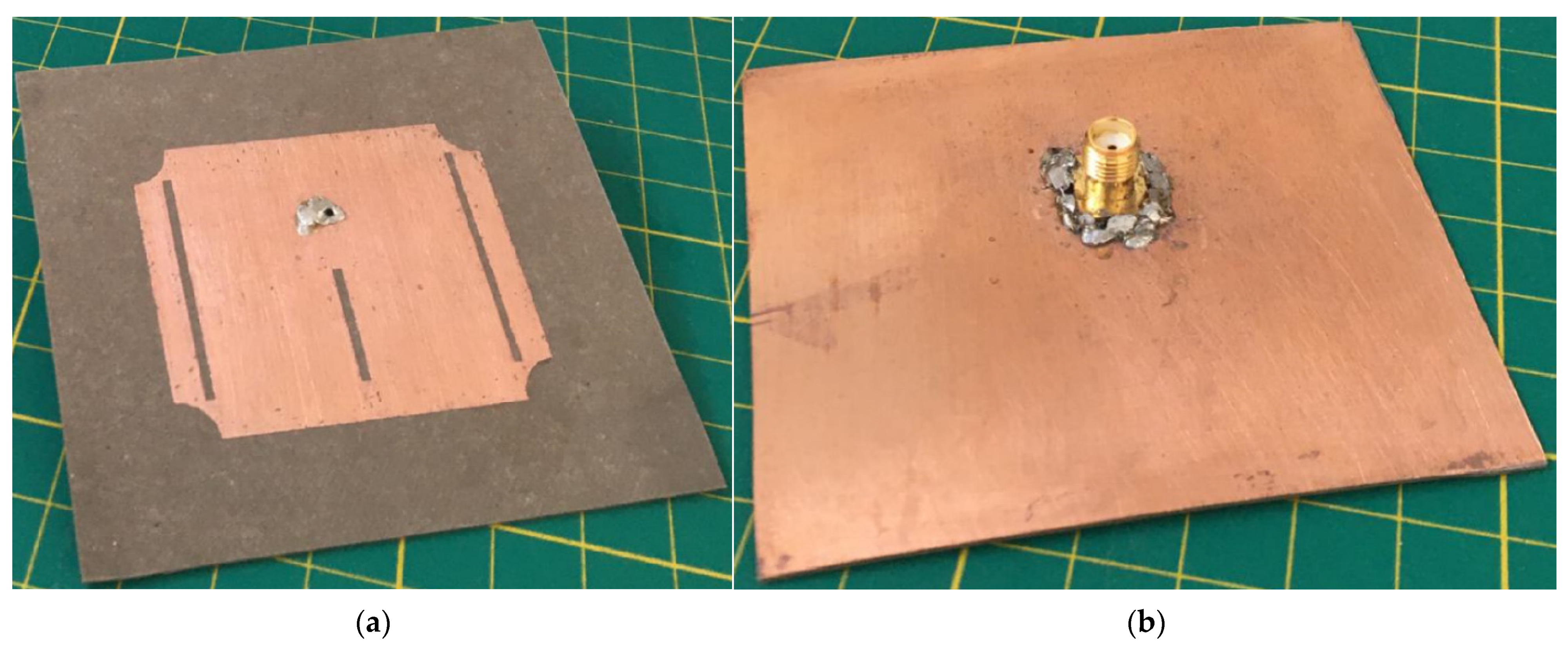
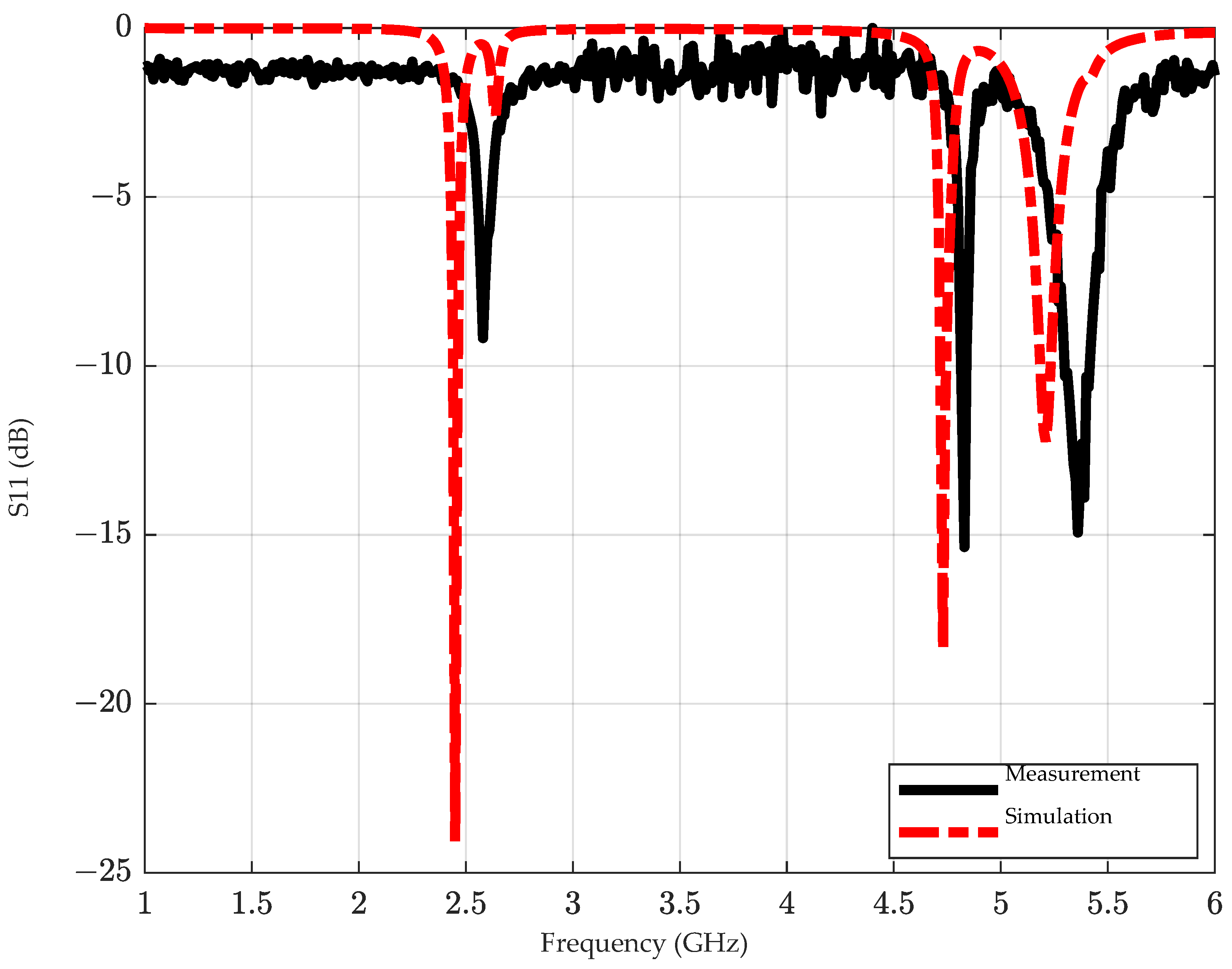
| Variables | Intervals and Number of Samples |
|---|---|
| slot Width 1 (sW1) | |
| slot Width 2 (sW2) | |
| slot Length 1 (sL1) | |
| slot Length 2 (sL2) | |
| radius of arc-truncation (r) | |
| number of training samples | 1100 |
| number of testing samples | 149 |
| total number of samples | 1249 |
| SVR Parameters | Selected Kernel Function Type and Parameter Values |
|---|---|
| Kernel function | Mexican-hat wavelet (19) |
| C | 2 × 1012 |
| ε | 5 × 10−4 |
| a | 2.97 |
| MPATSAT | [55] | [56] | [57] | [58] | [59] | [60] | [61] | [62] | |
|---|---|---|---|---|---|---|---|---|---|
| number of bands | triple | triple | triple | triple | triple | triple | triple | triple | triple |
| antenna dimensions L × W (mm) | 47.5 × 38.6 | 27 (radius) | 34 × 18 | 20 × 21 | 29 × 10 | 60 × 60 | 40 × 50 | 60 × 60 | 44 × 45 |
| substrate | RT Duroid 5870 | RT Duroid 5870 | FR-4 | FR-4 | FR-4 | FR-4 | FR-4 | denim | FR-4 |
| substrate thickness (mm) | 0.787 | 1.5 | 1.6 | 1.57 | 1.6 | 1.56 | 0.8 | 1 | 1.6 |
| resonance (operating) frequencies (GHz) | 2.5 4.8 5.3 | 1.8 2.4 5.4 | 2.5 3.5 5.5 | 1.29 2.44 3.26 | 2.4 3.5 5.5 | 2.6 4.2 4.6 | 1.65 1.93 2.2 | 2.45 3.25 5.8 | 2.39 3.55 4.13 |
| bandwidths (MHz) | 20 40 50 | - | 300 300 1000 | 210 300 1390 | 80 420 600 | 580 120 100 | 70 60 280 | 76 156 328 | 196 110 220 |
| gains at resonance frequencies (dB) | 3.1 3.8 7.1 | 5.5 7.8 7.9 | 0.28 1.42 4.76 | 1.29 2.44 3.26 | ~1.75 ~2 ~2.3 | 4.4 3.9 3.8 | 1.08 1.82 2.93 | 0.025 −1.871 3.703 | 4.05 2.52 2.15 |
| Parameter | GA | PS |
|---|---|---|
| number of parents (current gen.) | 30 | - |
| number of mates | 30 | - |
| number of children | 30 | - |
| crossover type | simulated binary | - |
| mutation type | polynomial | - |
| number of survivors | 10 | - |
| number of individuals (next gen.) | 30 | - |
| selection type | roulette | - |
| selection pressure | 10 | - |
| maximum number of iterations | 1000 | 1000 |
| mutation probability | 0.01 | - |
| crossover probability | 0.98 | - |
| cost function norm type | L1 | L1 |
| weights | 1 | 1 |
| SVR Model Approach | HFSS Optimization Tool (GA) | HFSS Optimization Tool (PS) | |
|---|---|---|---|
| computation time | 2 h and 36 min | 9 h and 46 min | 7 h and 32 min |
| TAEf (GHz) (24) | 0.17 | 0.34 | 0.31 |
| desired resonance frequencies (GHz) | 2.4 4.7 5.3 | 2.4 4.7 5.3 | 2.4 4.7 5.3 |
| computed resonance frequencies (GHz) | 2.45 4.73 5.21 | 2.37 4.52 5.17 | 2.33 4.54 5.38 |
| computed maximum realized gains at the resonance frequencies (dB) | 6.1 4.6 7.21 | 5.9 3.5 6.6 | 5.6 2.8 6.5 |
Publisher’s Note: MDPI stays neutral with regard to jurisdictional claims in published maps and institutional affiliations. |
© 2022 by the authors. Licensee MDPI, Basel, Switzerland. This article is an open access article distributed under the terms and conditions of the Creative Commons Attribution (CC BY) license (https://creativecommons.org/licenses/by/4.0/).
Share and Cite
Yiğit, M.E.; Günel, G.Ö.; Aydemir, M.E.; Günel, T. Soft Computing Approach to Design a Triple-Band Slotted Microstrip Patch Antenna. Appl. Sci. 2022, 12, 11923. https://doi.org/10.3390/app122311923
Yiğit ME, Günel GÖ, Aydemir ME, Günel T. Soft Computing Approach to Design a Triple-Band Slotted Microstrip Patch Antenna. Applied Sciences. 2022; 12(23):11923. https://doi.org/10.3390/app122311923
Chicago/Turabian StyleYiğit, Mahmud Esad, Gülay Öke Günel, Mustafa Emre Aydemir, and Tayfun Günel. 2022. "Soft Computing Approach to Design a Triple-Band Slotted Microstrip Patch Antenna" Applied Sciences 12, no. 23: 11923. https://doi.org/10.3390/app122311923
APA StyleYiğit, M. E., Günel, G. Ö., Aydemir, M. E., & Günel, T. (2022). Soft Computing Approach to Design a Triple-Band Slotted Microstrip Patch Antenna. Applied Sciences, 12(23), 11923. https://doi.org/10.3390/app122311923





